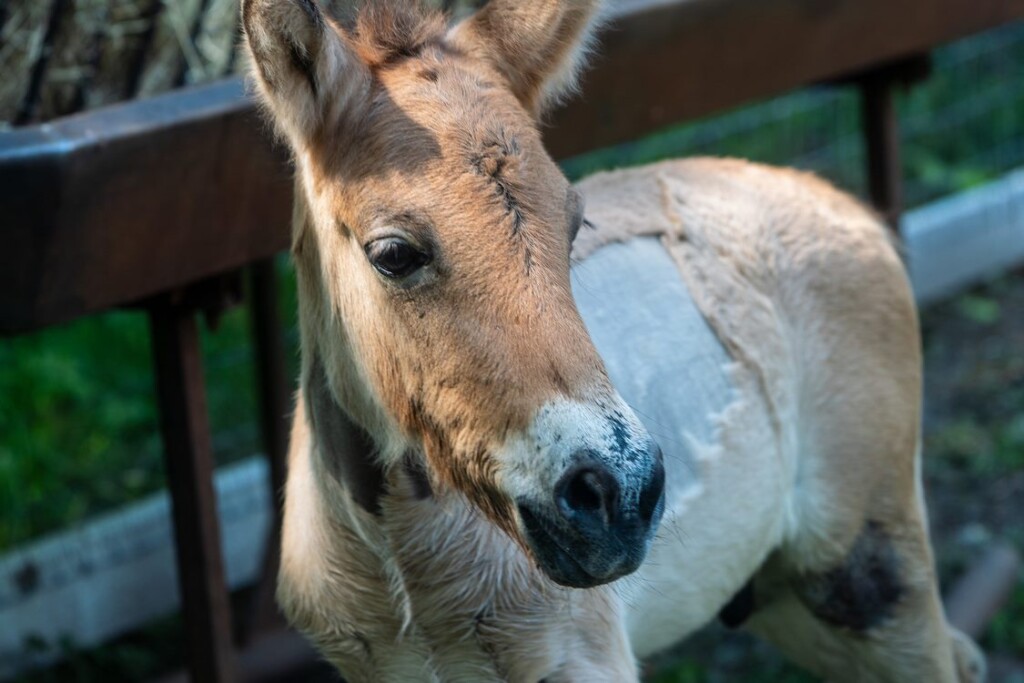
A story of resilience and maternal instinct comes now from Minnesota, where a foal belonging to Asia’s last remaining wild horse species is thriving thanks to an unexpected hero: a domesticated horse named Alice.
Having lost her own offspring, Alice decided to put Marat, the months old Przewalski’s horse foal, between her heart and her hooves.
Born May 17th at the Minnesota Zoo, the male foal is the result of a decades-long commitment to saving the endangered Przewalski’s horse, which over the last 15 years has progressed remarkably well.
Just days after his birth, the foal became critically ill and was transferred to the University of Minnesota’s Veterinary Medical Center. While he made a full recovery, the temporary separation led his mother, Nady, to reject him—a behavior not uncommon among wild horses after separation.
Enter Alice, a gentle Pony of the Americas mare from Brush Poppin Ranch in southeastern Minnesota. Just days earlier, Alice had lost her own newborn filly. Her owners, Sylvia and Jeff Passow, hoped her nurturing temperament and milk supply might help another foal in need.
Within hours of hearing about the orphaned wild foal, the Passows made the drive to the Minnesota Zoo. From their first meeting, Alice accepted Marat as her own, nuzzling him gently and allowing him to nurse. The two have formed a heartwarming bond, and Alice will remain by his side for the next several months as he continues to grow.

“This is the kind of story that reminds us of what conservation is all about: collaboration, compassion, and hope,” said Randy Kochevar, Chief Animal Care, Health, Conservation and Behavior Officer at the Minnesota Zoo. “Thanks to the Passows’ generosity and Alice’s instinct, this endangered foal now has a second chance.”
Przewalski’s horses are the world’s last truly wild horse species, never domesticated and genetically distinct from other horses. Once declared extinct in the wild by the 1960s, the species survived only through a small number of individuals in zoos.
Through decades of careful breeding, international cooperation, and scientific breakthroughs, including recent genetic research and cloning efforts, populations have been reestablished on the steppes of Mongolia and China. Fewer than 2,000 Przewalski’s horses exist today, making each foal born in human care critical to the species’ survival.
The Minnesota Zoo has long played a leading role in this global effort. Since opening in 1978, the Zoo has welcomed more than 50 foals as part of the Association of Zoos and Aquariums’ Species Survival Plan (SSP), which coordinates breeding to maintain genetic diversity.
In 2024, the Zoo contributed to a landmark genetic study aimed at strengthening future conservation efforts for the species.
Along with Mongolia and China, this year GNN reported that 150 animals have been transported to the steppes of Kazakhstan, another of the horse’s former pastures. Released at the Altyn Dala Reserve in Kazakhstan’s Kostanay region, it’s hoped they will naturally breed and spread out, eventually becoming prey for the Turanian tiger, an extinct local subspecies Kazakhstan is also attempting to reintroduce.
SHARE This Heart-Nuzzling Story Of Adoption And Mothering…
